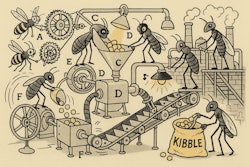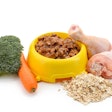
The chicken industry is rapidly evolving to meet the demands of time-pressed consumers who prioritize convenience and speed in meal preparation. With millennials and younger generations juggling careers and children, the industry is responding with innovative digital solutions and product adaptations that align with modern eating habits.
Consumer desire for convenience is also driving a technological revolution when it comes to purchasing chicken. Modern consumers now expect chicken products to come with QR codes with recipes, smart labels with information on how the birds were raised as well as recipe ideas, cooking instructions, online recipes that create a shopping list for all ingredients and tell you where those items are on sale and more.
Compared to other proteins, chicken has established itself as a standout for convenience-first eating habits. The ease of preparation represents chicken's most significant competitive advantage in the current market environment.

The protein's dominance extends beyond basic preparation simplicity. Chicken offers the widest variety of pre-prepared, refrigerated convenience options compared to other mainstream proteins. Products including nuggets, breaded wings, and other net-weight formats provide ready-to-cook solutions that eliminate preparation time while maintaining quality and flavor.
Broiler industry adapts
The broiler industry's vertical integration structure enables processors to
The industry has faced significant headwinds in recent years, with higher capital costs, elevated interest rates and tighter labor availability leading to a pause in new greenfield plant construction over the past four years. In response, processors have shifted focus to upgrading existing facilities with advanced processing equipment rather than expanding capacity.
"With tighter labor supplies, the industry is looking at replacing some of that labor with processing equipment," Earnest explained. This technological push has become increasingly critical as average bird weights have increased by approximately one pound over the past eight years, creating new challenges in meeting consumer portion size preferences.
One example of how processors have adapted is direct stream injection (DSI) cutting technology, which can portion larger breast meat into uniform sizes that meet retailer and foodservice specifications. This approach enables industry to benefit from the improved feed conversion efficiency of larger birds while still delivering consumer-preferred portion sizes.
In addition, the value-added chicken segment has evolved dramatically over the past 15 years, driven partly by the popularity of appliances like air fryers. Earnest noted that air fryers are now more common in U.S. homes than coffee makers. Several chicken processors have taken advantage of this trend, for example, in 2024, Perdue Foods released Air Fryer Ready Chicken Wings that were designed to cook easily in the appliance.
This trend has enabled consumers to recreate restaurant-quality breaded and par-fried chicken products at home, expanding the market for value-added chicken items beyond traditional take-and-bake formats.
Convenience drives demand

The industry has transformed chicken from primarily whole birds and bone-in parts to an array of convenient formats. For example, skinless, boneless options now dominate retail offerings, available in various pack sizes from large family portions to individually frozen pieces that reduce waste and accommodate different household needs.
Single-serving cuts have largely replaced whole birds, making chicken less intimidating and risky to prepare while reducing cooking time. Modern packaging now includes detailed preparation information, specifying cooking times and compatible appliances including air fryers, toaster ovens and microwaves.
In addition, despite increased competition from plant-based alternatives and other protein sources, there is significant untapped potential in the snacking category, said Dornblaser. The blurring line between meals and snacks, combined with consumer focus on protein intake, creates opportunities for chicken products designed specifically for snacking occasions.
"We see such a blurring just in the last five or 10 years between snacks and meals," she explained. "There's an opportunity there for products that are high protein, good solid nutrition, but are a smaller size and can be consumed as a snack."
Focus on consumer pain points
Kevin Ryan, founder and CEO of Malachite Strategy and Research, believes that, going forward, the chicken supply chain should focus on technologies that solve specific consumer problems rather than chasing technological trends for their own sake.
"We must see technology as a means to an end, and not just the thing itself," Ryan said. "Does this technology deliver on a consumer pain point? Does it provide a differentiating benefit for consumers compared to your competition?"
Today's consumers expect technology to cut through market noise and deliver personalized experiences in retail and foodservice. With value being a primary concern for many shoppers, technology can help highlight meal deals, sales or budget-friendly chicken recipes.
"I think that's one of the things that technology does. It helps people get what they want," Ryan explained. "Personalization is exciting for consumers. We talk a lot about artificial intelligence (AI), but for the consumer, that has to be translated into something."
When asked about the most exciting food technology innovations in chicken foodservice and retail, Ryan pointed to less flashy but potentially more impactful developments:
- Data integration systems connecting point-of-sale systems with social media sentiment
- Smart inventory systems that improve back-of-house efficiency
- Smart surfaces that reduce contamination
- In-store consumer decision-making tools and apps guiding nutritional purchases
- Health-focused wearable technology that monitors metrics like blood glucose
"The things that really excite me are probably the most mundane," Ryan noted. "There's going to be technologies out there that right now they're not getting a lot of attention, but in aggregate, I think they're going to have a huge impact."
Attend the 2025 Chicken Marketing Summit
Register to attend the 2025 Chicken Marketing Summit at the DeSoto Savannah in Savannah, Georgia, on July 28-30, 2025. This one-of-a-kind event will feature two content tracks. The first will focus on consumers and how technology impacts them, while the second will look at the impact new technologies have from an operational standpoint for chicken companies, retail and foodservice.
Serving a unique cross-section of the chicken supply chain, the Chicken Marketing Summit explores issues and trends in food marketing and consumer chicken consumption patterns and purchasing behavior.
Registration is now open.


















